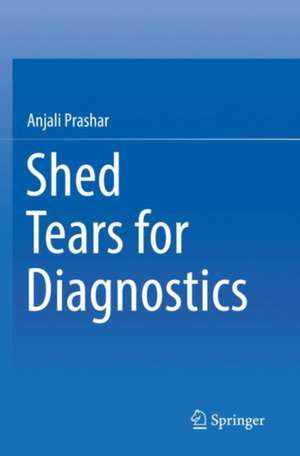Shed Tears for Diagnostics
Autor Anjali Prasharen Limba Engleză Paperback – 14 aug 2020
Previous literature on tear diagnostics has been restricted to scientific journal articles, most of which dealt with a single tear constituent, such as a protein. This book offers a far more comprehensive and handy ‘reference guide,’ presenting both basic and advanced information and data. Accordingly, it will be useful for researchers in academia and the pharmaceutical industry, as well as healthcare professionals and diagnostic kit developers.
| Toate formatele și edițiile | Preț | Express |
|---|---|---|
| Paperback (1) | 154.75 lei 3-5 săpt. | |
| Springer Nature Singapore – 14 aug 2020 | 154.75 lei 3-5 săpt. | |
| Hardback (1) | 154.75 lei 3-5 săpt. | |
| Springer Nature Singapore – 27 iun 2019 | 154.75 lei 3-5 săpt. |
Preț: 154.75 lei
Preț vechi: 162.90 lei
-5% Nou
Puncte Express: 232
Preț estimativ în valută:
29.61€ • 32.27$ • 24.95£
29.61€ • 32.27$ • 24.95£
Carte disponibilă
Livrare economică 03-17 aprilie
Preluare comenzi: 021 569.72.76
Specificații
ISBN-13: 9789811371714
ISBN-10: 9811371717
Pagini: 166
Ilustrații: XXI, 166 p. 8 illus., 6 illus. in color.
Dimensiuni: 155 x 235 mm
Greutate: 0.45 kg
Ediția:1st ed. 2019
Editura: Springer Nature Singapore
Colecția Springer
Locul publicării:Singapore, Singapore
ISBN-10: 9811371717
Pagini: 166
Ilustrații: XXI, 166 p. 8 illus., 6 illus. in color.
Dimensiuni: 155 x 235 mm
Greutate: 0.45 kg
Ediția:1st ed. 2019
Editura: Springer Nature Singapore
Colecția Springer
Locul publicării:Singapore, Singapore
Cuprins
Chapter 1. Introduction.- Chapter 2. Collection methods.- Chapter 3. Composition of tears.- Chapter 4. Tear profile of contact lens users.- Chapter 5. Cry baby: Tear profile of infants.- Chapter 6. Tear off the disease.- Chapter 7. Factors affecting tear health.- Chapter 8. Artificial tears.- Chapter 9. Proposed diagnostic comprehensive tear panels.- Chapter 10. Microfluidics in tear analysis.- Chapter 11. News bulletins.- Chapter 12. Bibliograpy.
Notă biografică
Dr. Anjali Prashar completed her postdoctoral research at King’s College, London, UK on a neuroendocrinology project based on melanopsin, an opsin found in the melanophores of Xenopus laevis. She previously received her Ph.D. degree from the University of Westminster, London, UK. Her Ph.D. thesis was amongst the first papers to indicate that some of the most commonly used essential oils (e.g. lavender oil) could potentially have an adverse effect on human skin.
Her experience in the field of scientific research stretches over many years and over varied areas of biotechnology and biomedical sciences. She also worked as a senior cell biologist at Hypha Discovery, a UK based biotech firm, where she focused on searching for novel anti-cancer compounds from fungal species including those of marine origin. She has several publications in peer-reviewed scientific journals to her credit, and is on the advisory board of the Journal of Basic Microbiology.
Her experience in the field of scientific research stretches over many years and over varied areas of biotechnology and biomedical sciences. She also worked as a senior cell biologist at Hypha Discovery, a UK based biotech firm, where she focused on searching for novel anti-cancer compounds from fungal species including those of marine origin. She has several publications in peer-reviewed scientific journals to her credit, and is on the advisory board of the Journal of Basic Microbiology.
Textul de pe ultima copertă
This book covers a wide range of topics concerning human tear based science, starting from basics such as the normal composition of tears and moving up to novel disease detection platforms. The entire approach is pioneering, as tears are beginning to be recognized as the most invaluable non-invasive tool in diagnostics. Interestingly, the concept is not restricted to ocular diseases: In recent years, tear diagnostics is increasingly being tapped even for cancer detection. Hopefully, non-invasive tear diagnostics will eventually replace today’s invasive disease detection and monitoring techniques.
Previous literature on tear diagnostics has been restricted to scientific journal articles, most of which dealt with a single tear constituent, such as a protein. This book offers a far more comprehensive and handy ‘reference guide,’ presenting both basic and advanced information and data. Accordingly, it will be useful for researchers in academia and the pharmaceutical industry, as well as healthcare professionals and diagnostic kit developers.
Previous literature on tear diagnostics has been restricted to scientific journal articles, most of which dealt with a single tear constituent, such as a protein. This book offers a far more comprehensive and handy ‘reference guide,’ presenting both basic and advanced information and data. Accordingly, it will be useful for researchers in academia and the pharmaceutical industry, as well as healthcare professionals and diagnostic kit developers.
Caracteristici
Summarizes the compositional aspects of tears Provides cutting-edge information on tears as a diagnostic and prognostic tool for ocular and non-ocular diseases alike Highlights the role of various biomarkers in tears Proposes tear based disease detection platforms Outlines pioneering concepts such as exploring the tears of twins or pregnant women for diagnostic markers
























